The evolution of short- and long-range weapons for bacterial competition
- PMID: 38036633
- PMCID: PMC10697841
- DOI: 10.1038/s41559-023-02234-2
The evolution of short- and long-range weapons for bacterial competition
Abstract
Bacteria possess a diverse range of mechanisms for inhibiting competitors, including bacteriocins, tailocins, type VI secretion systems and contact-dependent inhibition (CDI). Why bacteria have evolved such a wide array of weapon systems remains a mystery. Here we develop an agent-based model to compare short-range weapons that require cell-cell contact, with long-range weapons that rely on diffusion. Our model predicts that contact weapons are useful when an attacking strain is outnumbered, facilitating invasion and establishment. By contrast, ranged weapons tend to be effective only when attackers are abundant. We test our predictions with the opportunistic pathogen Pseudomonas aeruginosa, which naturally carries multiple weapons, including CDI and diffusing tailocins. As predicted, short-range CDI can function at low and high frequencies, while long-range tailocins require high frequency and cell density to function effectively. Head-to-head competition experiments with the two weapon types further support our predictions: a tailocin attacker defeats CDI only when it is numerically dominant, but then we find it can be devastating. Finally, we show that the two weapons work well together when one strain employs both. We conclude that short- and long-range weapons serve different functions and allow bacteria to fight both as individuals and as a group.
© 2023. The Author(s).
Conflict of interest statement
The authors declare no competing interests.
Figures
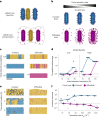


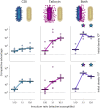
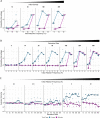
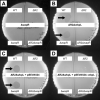
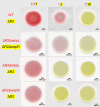





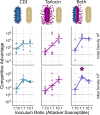

Similar articles
-
Cell motility empowers bacterial contact weapons.ISME J. 2024 Jan 8;18(1):wrae141. doi: 10.1093/ismejo/wrae141. ISME J. 2024. PMID: 39073907 Free PMC article.
-
Pseudomonas chlororaphis Produces Two Distinct R-Tailocins That Contribute to Bacterial Competition in Biofilms and on Roots.Appl Environ Microbiol. 2017 Jul 17;83(15):e00706-17. doi: 10.1128/AEM.00706-17. Print 2017 Aug 1. Appl Environ Microbiol. 2017. PMID: 28526791 Free PMC article.
-
Pseudomonas chlororaphis Produces Multiple R-Tailocin Particles That Broaden the Killing Spectrum and Contribute to Persistence in Rhizosphere Communities.Appl Environ Microbiol. 2018 Aug 31;84(18):e01230-18. doi: 10.1128/AEM.01230-18. Print 2018 Sep 15. Appl Environ Microbiol. 2018. PMID: 30030224 Free PMC article.
-
Phage tail-like particles are versatile bacterial nanomachines - A mini-review.J Adv Res. 2019 Apr 23;19:75-84. doi: 10.1016/j.jare.2019.04.003. eCollection 2019 Sep. J Adv Res. 2019. PMID: 31341672 Free PMC article. Review.
-
Antifungal weapons of Lysobacter, a mighty biocontrol agent.Environ Microbiol. 2021 Oct;23(10):5704-5715. doi: 10.1111/1462-2920.15674. Epub 2021 Jul 21. Environ Microbiol. 2021. PMID: 34288318 Review.
Cited by
-
Use of zebrafish to identify host responses specific to type VI secretion system mediated interbacterial antagonism.PLoS Pathog. 2024 Jul 18;20(7):e1012384. doi: 10.1371/journal.ppat.1012384. eCollection 2024 Jul. PLoS Pathog. 2024. PMID: 39024393 Free PMC article.
-
Overcoming toxicity: How nonantagonistic microbes manage to thrive in boom-and-bust environments.Proc Natl Acad Sci U S A. 2025 Jul;122(26):e2424372122. doi: 10.1073/pnas.2424372122. Epub 2025 Jun 26. Proc Natl Acad Sci U S A. 2025. PMID: 40569387
-
Architectural dissection of adhesive bacterial cell surface appendages from a "molecular machines" viewpoint.J Bacteriol. 2024 Dec 19;206(12):e0029024. doi: 10.1128/jb.00290-24. Epub 2024 Nov 5. J Bacteriol. 2024. PMID: 39499080 Free PMC article. Review.
-
The dominant lineage of an emerging pathogen harbours contact-dependent inhibition systems.Microb Genom. 2025 Jan;11(1):001332. doi: 10.1099/mgen.0.001332. Microb Genom. 2025. PMID: 39853206 Free PMC article.
-
Stress-driven temporal production of phage tail-like particles (tailocins) in Dickeya dadantii strain 3937.Sci Rep. 2025 Jul 26;15(1):27234. doi: 10.1038/s41598-025-13158-1. Sci Rep. 2025. PMID: 40715312 Free PMC article.
References
-
- Emlen, D. Animal Weapons: The Evolution of Battle (Picador, 2015).
MeSH terms
Substances
Grants and funding
LinkOut - more resources
Full Text Sources
Research Materials

